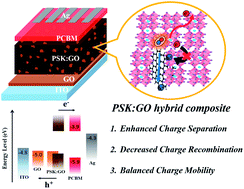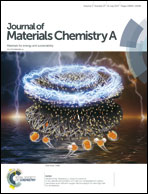Inverted planar solar cells based on perovskite/graphene oxide hybrid composites†
Abstract
Mixing graphene oxide (GO) with CH3NH3PbI3 (PSK) in varied proportions (0.025, 0.05 and 0.075 mg mL−1) and using GO nanosheets as a p-type electrode for devices with a layer-by-layer thin-film configuration ITO/GO/PSK:GO/PCBM/Ag produced hybrid composite perovskite solar cells. The efficiency of power conversion (PCE) of the device prepared with GO in PSK solution (0.05 mg mL−1) attained 15.2%, which is greater than that of a conventional planar heterojunction device (PCE 12.3%) fabricated using pristine PSK. In the homogeneous PSK:GO active layers, PSK acted as a hole donor and GO as a hole acceptor. The optimum GO concentration (0.05 mg mL−1) increased the charge mobility (investigated using Hall effect measurements), enhanced the charge separation (investigated using photoluminescence decays) and retarded the charge recombination (investigated using electrochemical impedance spectra), consistent with the trend of corresponding device performances. Our results thus indicate that the hybrid PSK:GO layer increased the interfacial contact between the donor and acceptor of holes to balance the charge mobility and improved the photovoltaic performance with excellent reproducibility and stability.


 Please wait while we load your content...
Please wait while we load your content...